As the Statue of Liberty stands tall in New York Harbor, it embodies the ideals of freedom, democracy, and opportunity that have shaped the United States for centuries. Its iconic imagery has become synonymous with the nation, inspiring countless individuals and serving as a beacon of hope for those seeking a better life.
From its historical significance to its cultural impact and educational value, the Statue of Liberty continues to captivate and inspire people worldwide. Its architectural grandeur and symbolism have made it a beloved landmark, while its enduring message of liberty and equality remains as relevant today as it was when it was first unveiled in 1886.
Historical Significance

The Statue of Liberty, a colossal neoclassical sculpture on Liberty Island in New York Harbor, is a potent emblem of freedom and democracy. Its history is intertwined with the United States’ founding ideals and its enduring aspiration for liberty.
Conceived by French sculptor Frédéric Auguste Bartholdi and built by Gustave Eiffel, the statue was a gift from the people of France to commemorate the centennial of the signing of the Declaration of Independence in 1876. It was dedicated on October 28, 1886, and quickly became a symbol of welcome and hope for immigrants arriving in the United States.
The Statue of Liberty, a symbol of freedom and democracy, stands proudly in New York Harbor. Its copper exterior has weathered the elements, turning a beautiful shade of green. While the statue is an iconic landmark of the United States, it has also inspired similar structures around the world, including a replica in the UAE.
This replica, located on an artificial island in Dubai, is a testament to the global reach of the Statue of Liberty’s message of hope and inspiration.
Symbolism and Ideals, Statue of liberty
The Statue of Liberty embodies several potent ideals:
- Liberty:The statue’s torch represents enlightenment and the pursuit of freedom.
- Democracy:The statue’s crown symbolizes the sovereignty of the people.
- Equality:The statue’s broken chains at her feet represent the rejection of tyranny and oppression.
- Progress:The statue’s forward-facing gaze signifies the nation’s optimistic outlook and belief in the future.
Significance of Location
The statue’s location in New York Harbor is highly symbolic. Situated at the entrance to the harbor, it greets visitors from all over the world, embodying the United States’ role as a beacon of hope and opportunity.
The statue’s proximity to Ellis Island, the former immigration station, further underscores its significance as a symbol of welcome and acceptance for those seeking a new life in America.
Architectural Design

The Statue of Liberty, a symbol of freedom and democracy, is a remarkable architectural achievement. Designed by French sculptor Frédéric Auguste Bartholdi, the statue was constructed using innovative techniques and materials.Bartholdi’s design was inspired by the Roman goddess Libertas, who represents liberty.
The statue depicts a woman wearing a flowing gown, holding a torch in her right hand and a tablet in her left. The tablet bears the inscription “JULY IV MDCCLXXVI,” commemorating the signing of the United States Declaration of Independence.
Construction
The statue’s frame was constructed using wrought iron, which was then covered with copper sheets. The copper sheets were hammered into shape and riveted together, creating a durable and weather-resistant exterior. The statue’s pedestal was built from granite, quarried from Bedloe’s Island (now Liberty Island).
Architectural Style
The Statue of Liberty is a unique blend of architectural styles. The statue’s classical form and proportions are reminiscent of ancient Greek and Roman sculptures. However, the statue’s use of modern materials and construction techniques, such as wrought iron and copper, reflects the Industrial Revolution era.
Standing tall and proud in New York Harbor, the Statue of Liberty is an iconic symbol of freedom and democracy. Its grandeur and symbolism resonate around the world. While the statue is a must-see for any visitor to the city, one can also experience a different kind of wonder in the coastal paradise of Jimbaran, Bali.
Known for its delectable Jimbaran seafood grilled to perfection on the beach, it offers a tantalizing culinary adventure that complements the Statue of Liberty’s inspiring presence.
Influence
The Statue of Liberty has had a profound influence on architecture and design. The statue’s iconic form has been replicated and reinterpreted in countless works of art, architecture, and popular culture. The statue’s message of freedom and democracy has also inspired generations of people around the world.
Cultural Impact
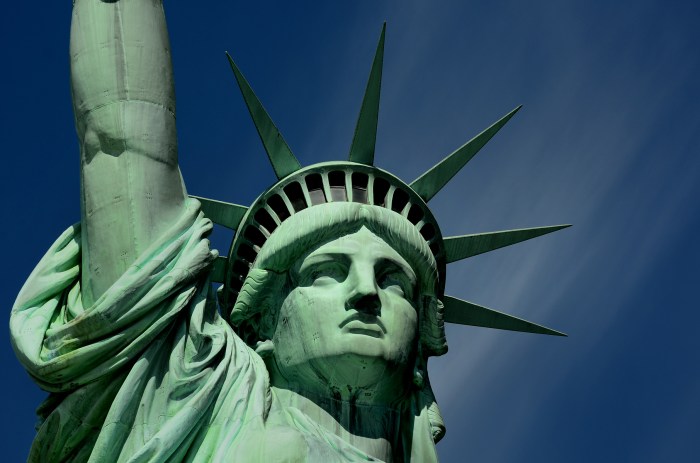
The Statue of Liberty has become an enduring symbol of freedom and immigration. It has inspired countless works of art, literature, and popular culture.
Symbol of Freedom
The statue’s torch represents the light of liberty that guides people to freedom. It has been a beacon of hope for immigrants and refugees seeking a new life in the United States. The statue’s inscription, “Give me your tired, your poor, your huddled masses yearning to breathe free,” has become a symbol of the country’s commitment to welcoming people from all walks of life.
Symbol of Immigration
The Statue of Liberty has also become a symbol of immigration. It stands on Liberty Island, which was once a major immigration station. Millions of immigrants passed through the island on their way to the United States. The statue has become a reminder of the struggles and triumphs of those who came to America in search of a better life.
Representation in Art, Literature, and Popular Culture
The Statue of Liberty has been depicted in countless works of art, literature, and popular culture. It has been featured in paintings, sculptures, poems, songs, and movies. The statue’s iconic image has become a symbol of hope, freedom, and the American dream.
Restoration and Preservation
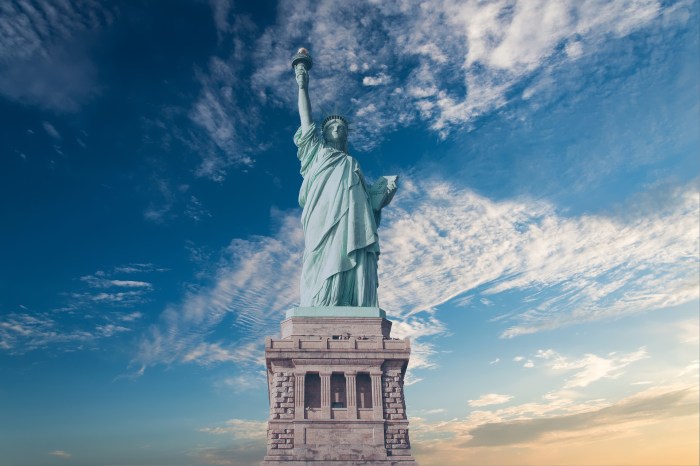
The Statue of Liberty has undergone several major restorations and preservation efforts throughout its history. The first major restoration took place in 1984-1986, when the statue was cleaned, repaired, and reinforced. The torch was replaced with a new one made of copper, and the original torch was placed on display in the Statue of Liberty Museum.In 2011, the statue was closed for a year-long renovation project to repair damage caused by Hurricane Sandy.
The project included replacing the statue’s skin, repairing the pedestal, and installing a new lighting system.The Statue of Liberty is an iconic symbol of freedom and democracy, and it is important to preserve its historical and cultural value. The ongoing restoration and preservation efforts ensure that the statue will continue to be a source of inspiration for generations to come.
Tourism and Public Access
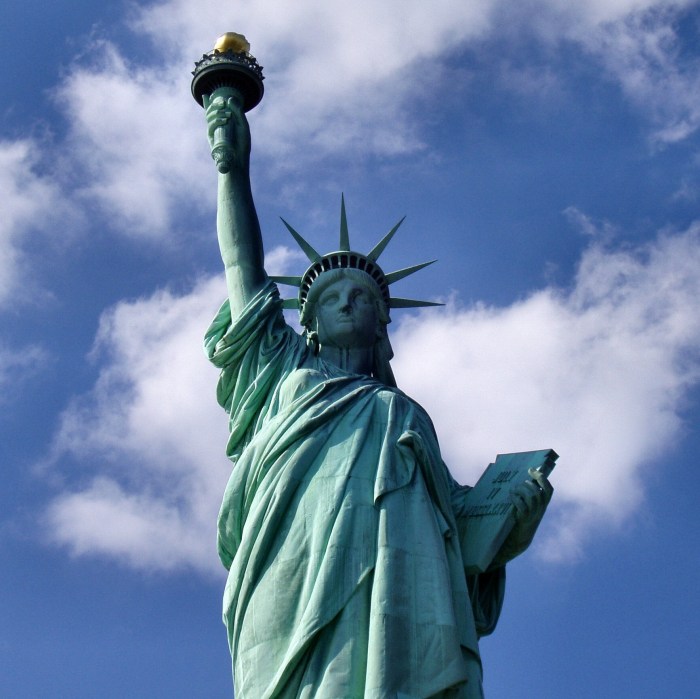
The Statue of Liberty is one of the most iconic landmarks in the world, attracting millions of visitors each year. Visiting the statue is a unique and unforgettable experience, offering breathtaking views of New York City and the surrounding area.There are several different ways to visit the Statue of Liberty.
Visitors can take a ferry from Battery Park in Manhattan or Liberty State Park in New Jersey. The ferry ride takes about 20 minutes and offers stunning views of the statue and the skyline of New York City. Once on Liberty Island, visitors can explore the statue’s base, climb to the crown (reservations required), or visit the museum.The Statue of Liberty is a popular tourist destination, and as such, it can be crowded, especially during peak season.
To avoid the crowds, it is best to visit during the off-season or on a weekday. Visitors should also be aware that there are security checks in place before boarding the ferry.The impact of tourism on the Statue of Liberty is significant.
The revenue generated from tourism helps to fund the statue’s maintenance and preservation. However, the large number of visitors can also put a strain on the site. To minimize the impact of tourism, the National Park Service has implemented a number of measures, such as limiting the number of visitors who can climb to the crown each day.
Educational Value
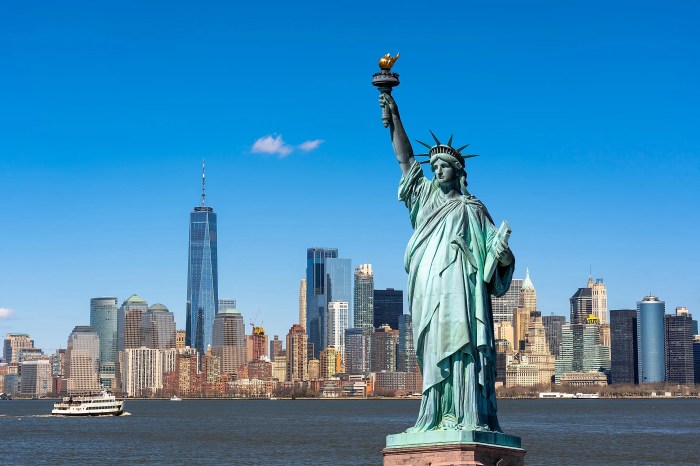
The Statue of Liberty serves as a profound educational tool, offering invaluable insights into history, civics, and cultural studies.
It provides a tangible representation of pivotal historical events, such as the American Revolution and the abolition of slavery, fostering a deeper understanding of the nation’s past.
Teaching History
- The statue’s design and symbolism offer a window into the aspirations and values of the American people during the late 19th century.
- It illuminates the struggles and triumphs of immigrants seeking a better life in the United States.
- Educational programs at the site, such as guided tours and interactive exhibits, provide immersive experiences that bring history to life.
Teaching Civics
- The Statue of Liberty embodies the ideals of democracy, liberty, and equality, serving as a powerful reminder of the principles upon which the nation was founded.
- It fosters discussions on the rights and responsibilities of citizenship, as well as the importance of civic engagement.
- Educational resources, such as online lesson plans and curriculum materials, connect the statue to contemporary issues and encourage students to become active citizens.
Teaching Cultural Studies
- The Statue of Liberty represents the fusion of diverse cultures that have shaped American society.
- It provides a platform for exploring themes of immigration, assimilation, and cultural identity.
- Educational programs at the site highlight the contributions of various immigrant groups to American culture, promoting cross-cultural understanding and appreciation.
Comparable Monuments
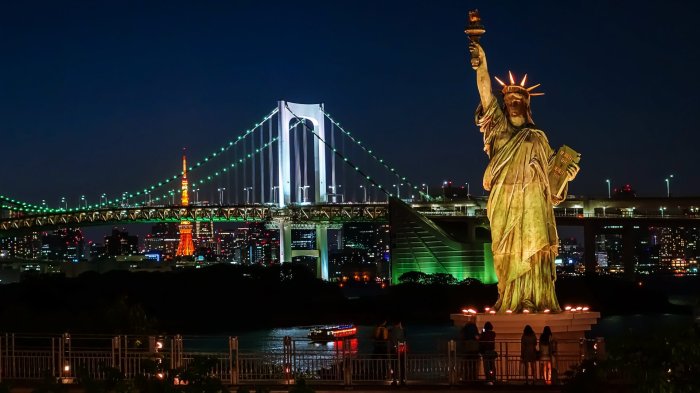
The Statue of Liberty stands tall as an iconic symbol of freedom and democracy, but it is not the only notable monument that captivates the world. Other monuments, each with its own unique design, symbolism, and historical significance, have left an enduring mark on human history.
To gain a deeper understanding of the Statue of Liberty’s place among these architectural wonders, let’s compare it to several other renowned monuments worldwide.
Design and Symbolism
The Statue of Liberty’s towering figure, holding a torch aloft, is instantly recognizable. However, other monuments also employ distinct design elements to convey their symbolic meanings:
- Eiffel Tower (Paris, France):A latticework structure that embodies the industrial prowess of the late 19th century, symbolizing technological advancement and architectural innovation.
- Sydney Opera House (Sydney, Australia):A series of white, sail-like structures that represent the country’s maritime heritage and artistic vibrancy.
- Taj Mahal (Agra, India):A white marble mausoleum with intricate carvings, symbolizing the enduring love of Emperor Shah Jahan for his wife, Mumtaz Mahal.
Historical Significance
The Statue of Liberty was a gift from France to commemorate the alliance between the two nations during the American Revolution. It became a symbol of freedom and opportunity for immigrants arriving in the United States.
The Statue of Liberty, a symbol of freedom and democracy, stands tall and proud. Its majestic presence reminds us of the values we hold dear. Across the globe, in the vibrant city of Jakarta, the Fraser Residence Menteng Jakarta offers a luxurious haven for travelers.
With its prime location and exceptional amenities, this residence mirrors the spirit of the Statue of Liberty, providing a sense of tranquility and freedom amidst the bustling metropolis. And so, as we marvel at the Statue of Liberty’s enduring legacy, we find echoes of its grandeur in the comforts and hospitality of the Fraser Residence Menteng Jakarta.
Similarly, other monuments hold great historical significance:
- Great Wall of China (China):Built over centuries to protect the country from invaders, it represents China’s resilience and architectural ingenuity.
- Stonehenge (Wiltshire, England):A prehistoric monument of unknown origin, shrouded in mystery and believed to have religious or astronomical significance.
- Christ the Redeemer (Rio de Janeiro, Brazil):A colossal statue overlooking the city, symbolizing the Christian faith and Brazil’s cultural identity.
Comparative Table
The following table provides a concise comparison of key features of the Statue of Liberty and other notable monuments:
| Monument | Design | Symbolism | Historical Significance |
|---|---|---|---|
| Statue of Liberty | Copper statue on a stone pedestal | Freedom, democracy, opportunity | Gift from France, symbol of alliance and immigration |
| Eiffel Tower | Latticework structure | Industrial prowess, technological advancement | Built for the 1889 World’s Fair |
| Sydney Opera House | White, sail-like structures | Maritime heritage, artistic vibrancy | Iconic architectural landmark |
| Taj Mahal | White marble mausoleum | Enduring love, architectural beauty | Tomb of Emperor Shah Jahan’s wife |
| Great Wall of China | Stone and brick fortification | Resilience, architectural ingenuity | Built to protect China from invaders |
| Stonehenge | Stone circle | Mystery, religious or astronomical significance | Prehistoric monument of unknown origin |
| Christ the Redeemer | Colossal statue | Christian faith, Brazilian identity | Symbol of Rio de Janeiro and Brazil |
Iconic Imagery
The Statue of Liberty is one of the most iconic images in the world, instantly recognizable and associated with the United States. Its image has been used in countless photographs, advertisements, and media, shaping the public perception of the monument and its symbolism.
Photography
The Statue of Liberty has been a popular subject for photography since its unveiling in 1886. Its colossal size and dramatic setting in New York Harbor make it an ideal subject for both professional and amateur photographers. Many iconic photographs of the statue have been taken, including Alfred Stieglitz’s 1902 “The Steerage,” which captures the Statue of Liberty as a symbol of hope for immigrants arriving in the United States.
Advertising
The Statue of Liberty’s image has also been used extensively in advertising. Its association with freedom, democracy, and opportunity has made it a popular symbol for companies and products. Some notable examples include the “I ♥ NY” campaign, which featured the Statue of Liberty as a symbol of New York City, and the “We Can Do It!” poster, which used the statue’s image to inspire American workers during World War II.
Media
The Statue of Liberty has been featured in countless films, television shows, and other media. Its iconic image has been used to represent everything from the American Dream to the fight against terrorism. In the 1984 film “Ghostbusters,” the Statue of Liberty is famously brought to life to help defeat the villainous Gozer.The widespread use of the Statue of Liberty’s image in photography, advertising, and media has had a profound impact on the public perception of the monument.
It has helped to solidify the Statue of Liberty as a symbol of the United States and its values, and has made it one of the most recognizable and beloved landmarks in the world.
Final Review

The Statue of Liberty stands as a testament to the power of human aspiration and the enduring spirit of freedom. Its message of hope and opportunity continues to resonate with people from all walks of life, making it an enduring symbol of the American dream and a reminder of the ideals that have shaped the nation.
FAQ Overview: Statue Of Liberty
What is the height of the Statue of Liberty?
The Statue of Liberty stands 151 feet tall from its base to the tip of its torch.
When was the Statue of Liberty dedicated?
The Statue of Liberty was dedicated on October 28, 1886.
Who designed the Statue of Liberty?
The Statue of Liberty was designed by French sculptor Frédéric Auguste Bartholdi.
What is the Statue of Liberty made of?
The Statue of Liberty is made of copper sheets over a wrought iron framework.
